
| Publisher: | Perigee | |
| Genre: | Art, General, Collecting, Popular Culture | |
| ISBN: | 9780399537011 | |
| Pub Date: | November 2011 | |
| Price: | $18.95 |
| Nonfiction |
by Michael Popek
Used books and bookselling have been in Michael Popek's blood since he was a child. In Forgotten Bookmarks, he shares an unusual collection of the things he's discovered tucked inside the pages of books, "treasures within treasures... often untouched for decades." The ephemera includes personal photographs, baseball and greeting cards, poems, shopping lists, recipes, invitations, report cards, burial vault information, razor blades, marijuana leaves and handwritten letters (received or unsent).
Each bookmark specimen has been reproduced, as found, and displayed next to a picture of the original book where the discovery was made. In a scrapbook-like presentation, Popek takes the liberty of transcribing some illegible handwriting, but otherwise offers no commentary, preferring instead to let each relic and book exhibit speak for itself. This approach deepens reader fascination, heightening the intrigue of trying to determine the significance (if any) of the ephemera and book in combination. --Kathleen Gerard, blogger at Reading Between the Lines
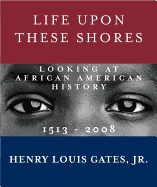
| Publisher: | Knopf | |
| Genre: | United States, General, History, Biography & Autobiography, Cultural Heritage, Ethnic Studies, Social Science, African American Studies - General | |
| ISBN: | 9780307593429 | |
| Pub Date: | November 2011 | |
| Price: | $50 |
| Nonfiction |
by Henry Louis Gates, Jr.
Henry Louis Gates, Jr.'s Life Upon These Shores is an encyclopedic history that begins with the Africans who traded alongside Spanish conquistadors in the New World and keeps going until Barack Obama’s inauguration as the first African American president of the United States. Famous and infamous historical figures share the stage with less easily recognized names such as Phyllis Wheatley, Briton Hammon and Jupiter Hammon, common men and women whose writings helped forge new cultural traditions. Gates, who has written prolifically about what it means to be black in America, presents a stunning pictography of black contributions to the American identity, deftly mixing high culture and pop culture to prove his points. Nothing is too trivial for consideration, and it all adds to the depth and fecundity of the African American cultural mystique, enriching and deepening American culture as a whole. --Nancy Powell, freelance writer and technical consultant
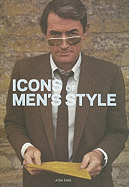
| Publisher: | Laurence King | |
| Genre: | Fashion, Design | |
| ISBN: | 9781856697224 | |
| Pub Date: | June 2011 | |
| Price: | $29.95 |
| Nonfiction |
by Josh Sims
As Josh Sims (Cult Streetwear) argues in the beautifully illustrated, oversize Icons of Men's Style, male fashion almost always consists of variations on a well-known theme, a generally conservative one. He focuses on several of these "iconic" themes, with chapters on outerwear, underwear, trousers, shoes, shirts and accessories. Within these parameters, he identifies the key clothing items that have made the greatest contributions to men's style--many of them adorning Hollywood's most stylish actors. (But not exclusively: Bing Crosby, Frank Sinatra and John F. Kennedy take their place next to Cary Grant, Humphrey Bogart and Steve McQueen.)
Here one finds the duffle coat, the flight jacket, cargo pants and Bermuda shorts, the loafer and the brogue, the polo and lumberjack shirt, and aviator sunglasses. Sims is especially good at showing how some items were co-opted and transformed into subculture essentials, such as Dr. Martens (made famous in The Who song "Uniforms"). His presentation makes Icons of Men's Style a perfect gift for a new student of fashion history or a clerk in a serious men's clothing store. --Thomas Lavoie, former publisher

| Publisher: | Welcome Books | |
| Genre: | General, Gay & Lesbian, Biography & Autobiography, Social Science, Gender Studies, Photography | |
| ISBN: | 9781599621043 | |
| Pub Date: | September 2011 | |
| Price: | $45 |
| Nonfiction |
by Scott Pasfield, with an introduction by Terence McNally and Tom Kirdahy
Pasfield criss-crossed the United States photographing gay men and couples (plus a few triads) and collecting their stories, hoping to create "the book I wish had existed when I was a kid." Any way you measure the breadth of his search--from William, who returned to his home on Alabama's Gulf Coast after more than a decade abroad, to Paul, a college student in Wyoming; or from the "true gay redneck" in Maryland to the Iowa drag queen--he's found a lot of powerful stories. Several of his subjects came out as gay only after years of marriage, for example, while others are carrying on with their lives after the loss of a longtime partner. And some live quietly in their communities as, in the words of one couple, "pretty plain, low-key" folks. Each story offers its own version of gay identity; together they form a rich tapestry of optimism and possibility. --Ron Hogan, founder of Beatrice.com

| Publisher: | Artisan | |
| Genre: | General, History, Biography & Autobiography, Military | |
| ISBN: | 9781579654627 | |
| Pub Date: | November 2011 | |
| Price: | $45 |
| Nonfiction |
by
Medal of Honor begins with a thoughtful, detailed yet succinct history of the Congressional Medal of Honor, providing an excellent introduction to the subject; later chapters include letters from every living U.S. president and short essays on wars from World War II through Afghanistan. But Peter Collier's real achievement lies in the 144 profiles of Medal of Honor recipients, representing every branch of the military, accompanied by Nick Del Calzo's stunningly beautiful photographic portraits. Collier's profiles tell of the circumstances leading to each citation, along with details of the recipients' lives that illuminate themes of humility, friendship and service. With one page devoted to each, Medal of Honor makes for easy coffee-table reading, and it's tempting to read them all in one sitting. This incredibly touching commemoration transcends politics to celebrate the contributions of brave, and selfless individuals in simple, glowing stories. --Julia Jenkins, librarian and blogger at pages of julia
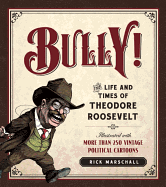
| Publisher: | Regnery | |
| Genre: | Modern, Humor, Form, Comic Strips & Cartoons, History, Biography & Autobiography, 20th Century, Presidents & Heads of State | |
| ISBN: | 9781596981546 | |
| Pub Date: | October 2011 | |
| Price: | $32 |
| Nonfiction |
by Rick Marschall
Contemporary audiences love the political satire of The Daily Show, Saturday Night Live and late-night talk-show hosts, but before television and the Internet, people relied on the cartoons in newspapers and magazines for humorous takes on their politicians. They were so numerous that one could, in fact, tell a American president's biography with them, which is just what popular culture historian Rick Marschall has done with Theodore Roosevelt's life in Bully!
More than 250 vintage political cartoons, many from Marschall's own collection, "unveil for us the caricatured Roosevelt, revealing an aspect of the man's character that has been little explored." These images show us the hunter, hiker, sportsman, naturalist and boxer who was popular with late 19th- and early 20th-century Americans, from his days with the Rough Riders through the governorship of New York and the vice-presidency into the White House, and as a beloved president who continued to fight fiercely for his beliefs after leaving office. --Tom Lavoie, former publisher
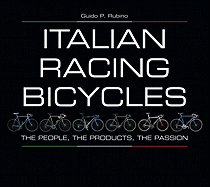
| Publisher: | VeloPress | |
| Genre: | General, Transportation, Sports & Recreation, Cycling, Motorcycles | |
| ISBN: | 9781934030660 | |
| Pub Date: | October 2011 | |
| Price: | $39.95 |
| Nonfiction |
by Guido P. Rubino
Passionate fans of Italian bicycles, professional bicycle racing, the history of the sport and/or fine craftsmanship must add Italian Racing Bicycles to their collections. It's not just about bicycles, as the title suggests, but about the companies that made (and still make) them and about the Italian cyclists who ride competitively. Top-of-the-line Italian bikes are works of art as well as masterpieces of function, and Guido Rubino considers 40 of the finest manufacturers: their histories, likely futures, personalities and history-making products. The indispensable Colnago, Campagnolo and Bianchi brands are covered, as are the men who originally bore those names. Racing greats such as Coppi, Pantani, Sarroni and Bartali, whose performances helped establish the legacies of these companies, receive well-deserved attention here as well (along with select non-Italians like Eddy Merckx). Plenty of beautiful pictures complete this lovely coffee-table book. --Julia Jenkins, librarian and blogger at pages of julia
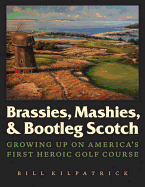
| Publisher: | University of Nebraska Press | |
| Genre: | State & Local - Middle Atlantic, United States, General, Sports & Recreation, History, 20th Century, Golf | |
| ISBN: | 9780803236424 | |
| Pub Date: | October 2011 | |
| Price: | $16.95 |
| Nonfiction |
by Bill Kilpatrick
Brassies, Mashies, and Bootleg Scotch oozes golf nostalgia. Bill Kilpatrick, the former golf writer for the Fort Myers News-Press, tells the story of his father, who was born in Scotland and raised near St. Andrews, then came to the United States, where he worked as an itinerant greenkeeper (what we call today a golf course superintendent). He moved from course to course in the 1920s and 1930s, helping restore those that had been neglected, and lucky at times to work at those that were among the very best--Maidstone in East Hampton, N.Y., and the National Golf Links on New York's Great Peconic Bay.
Kilpatrick grew up on the courses, too. It was a hard life but an idyllic one, a "magic one," cutting the fairways and greens with huge mowers, raking bunkers and sometimes caddying for the occasional player who tipped well. Today, he writes, "the game no longer is played but rather is worked at." Lucky Bill, to have had such a childhood. --Tom Lavoie, former publisher

| Publisher: | Abrams | |
| Genre: | Literary Criticism, Science Fiction & Fantasy | |
| ISBN: | 9780810989580 | |
| Pub Date: | May 2011 | |
| Price: | $24.95 |
| Nonfiction |
by Jeff VanderMeer with S.J. Chambers
Steampunk is loosely defined as a marriage of Victorian visual elements with traditional components of science fiction, and a dash of punk sensibility thrown in for good measure. The Steampunk Bible traces the phenomenon's arc from fringe book genre to stylish subculture, reaching back to the initial influence of visionary writers such as Jules Verne, H.G. Wells and Edgar Allan Poe while covering the prevalence of contemporary steampunk art, design and fashion.
Jeff VanderMeer and S.J. Chambers have compiled a selection of illustrations, photographs and articles that take the reader beyond the basic information and deep into the clockwork. There are even instructions on how to create one's own etched tin box--an intriguing process that is part craft and part science project. A fun and thorough examination of subgenres and lists of must-read books and must-watch movies await the eager steampunk adherent ready for adventure, viewing the world through aviator goggles. --Sarah Borders, librarian, Houston Public Library

| Publisher: | Heyday Books | |
| Genre: | Art, General, American | |
| ISBN: | 9781597141642 | |
| Pub Date: | November 2011 | |
| Price: | $45 |
| Nonfiction |
by Susan Snyder
Most diaries provide a glimpse into their creators' lives, but Beyond Words delivers far more: a feast for the eyes and a fascinating peek into U.S. history. Archivist Susan Snyder has selected excerpts from 50 illustrated diaries spanning more than 200 years, culled from the special collections of the Bancroft Library at UC-Berkeley. While a few diarists' names are familiar--John Muir, Mark Twain, Lawrence Ferlinghetti--most chronicle the lives of ordinary people, encompassing travel notes, poetry, ship's logs, pencil sketches and even full-color drawings. The collection is heavy on California history, but spans a variety of experiences: from camping trips in Yosemite Valley to life in a Japanese-American internment camp during World War II to adventure on the high seas. Snyder's informative commentary provides context and detail, while the diary pages, presented in stunning visual detail, pull readers into their creators' worlds. --Katie Noah Gibson, blogger at Cakes, Tea and Dreams
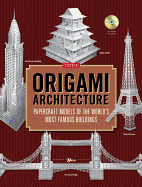
| Publisher: | Tuttle | |
| Genre: | Crafts & Hobbies, Origami | |
| ISBN: | 9784805311547 | |
| Pub Date: | October 2011 | |
| Price: | $24.95 |
| Nonfiction |
by Yee
Yee (yes, just Yee) is a world-renowned papercrafter, and in Origami Architecture he offers readers a global portfolio of construction projects, with step-by-step instructions for paper models of 16 landmarks, from the Arc de Triomphe to Westminster Palace. After a shopping list of suitable materials and necessary tools, Yee provides general guidelines and tips, some of which have the tenor of fortune cookies, as applicable to daily life as they are to papercraft: "You must understand completely what you are trying to do before you do it."
Each section of Origami Architecture begins with a brief history of the actual building, including its construction, giving the dimensions of both the original and the paper model with a note about the level of difficulty. (Amazingly, half of the buildings can be built with almost no glue, including the White House, London's Tower Bridge and the Parthenon.) With templates for each model conveniently available as printable PDFs on an accompanying CD-ROM, Origami Architecture has almost everything aspiring papercrafters need to recreate architectural landmarks in their own homes and workshops. --Sarah Borders, librarian, Houston Public Library

| Publisher: | Black Dog & Leventhal | |
| Genre: | Needlework, Crafts & Hobbies, Knitting, Stuffed Animals | |
| ISBN: | 9781579128746 | |
| Pub Date: | February 2011 | |
| Price: | $14.95 |
| Nonfiction |
by Sally Muir, Joanna Osborne
Knit Your Own Dog is more fun than a litter of pups. In fact, it is a litter of pups--25 purebreds depicted in knitting patterns (plus suggestions for creating your own mutt). Following the clear instructions from British needleworkers Sally Muir and Joanna Osborne (with American measurements), a novice knitter can whelp a new best friend in a few evenings. Close-up photos provide guidance on the fine details, such as properly perky ear placement and the terrier's "idiosyncratic square muzzle." The designers are witty and unabashed dog-lovers, and introductions to each design include history and fun facts about each breed. A determined knitter can quickly create a litter, mixed or matched, to meet all gift-giving needs. Not crafty with needles and yarn? Pick up this charming, easy-to-follow collection of patterns and if your pooch doesn’t come to life, just enjoy the pictures and stories by these needlework (and dog) experts. --Cheryl Krocker McKeon, bookseller
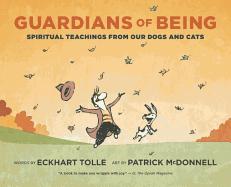
| Publisher: | New World Library | |
| Genre: | Inspirational, Pets, General, Cats, Self-Help, Religion, Dogs, Motivational & Inspirational | |
| ISBN: | 9781608681198 | |
| Pub Date: | November 2011 | |
| Price: | $14.95 |
| Nonfiction |
by Eckhart Tolle, illust. by Patrick McDonnell
We love our cats and dogs, as spiritual master Eckhart Tolle and cartoonist Patrick McDonnell know all too well. Could we love them not simply because they're so much fun, but also because they have profound life lessons to teach us? In Guardians of Being (first published in 2009), Tolle holds up animals' simplicity as a virtue, asserting that their joy, their unself-conscious is-ness, can help humans appreciate the wonder of the present moment.
This is not a new idea, but McDonnell's cartoons, featuring beloved characters from his Mutts strip--Mooch, Earl, Ozzie and friends--keep it fresh. Both the text and the drawings can evoke smiles upon a quick reading or glance, but following Tolle's directive to sit and savor them will yield more of the promised wonder and peace. (Warning: non-pet owners may find themselves scurrying to the shelter to adopt a furry Zen-master friend of their own.) --Katie Noah Gibson, blogger at Cakes, Tea and Dreams
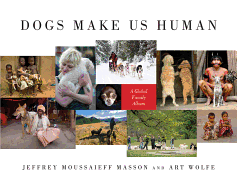
| Publisher: | Bloomsbury | |
| Genre: | Pets, General, Plants & Animals, Dogs, Subjects & Themes, Photography | |
| ISBN: | 9781608195657 | |
| Pub Date: | September 2011 | |
| Price: | $30 |
| Starred | Nonfiction |
by Jeffrey Moussaieff Masson, Art Wolfe
A collaboration by Jeffrey Moussaieff Masson, whose earlier books explored animal emotions, and nature photographer Art Wolfe, Dogs Make us Human is an unabashed homage to man’s best friend. Wolfe snapped 100 photos of dogs from all over the globe, and some of the dearest shots are the most unlikely: the Ethiopian babe wrapped in his mother’s robe, clutching a puppy, or the Indian sadhu and his devoted dog, companions despite the culture’s traditional scorn for canines. A chihuahua in his little leathers in a gay pride parade shares common ground with a Hindu holy man’s terrier sporting a beaded collar and a bindi on her forehead. Herding dogs, guide dogs, pampered dogs with painted nails, Mongolian wolf-chasing dogs, a California K-9 explosive-sniffing dog.... This collection invites reading and browsing and many return visits by dog lovers, photography fans, and anyone interested in human/pet relationships. Even a cat person will enjoy this book! --Cheryl Krocker McKeon, bookseller
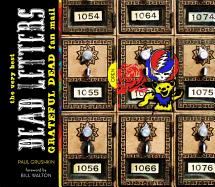
| Publisher: | Voyageur Press | |
| Genre: | Biography & Autobiography, Rock, Music, Composers & Musicians, Genres & Styles | |
| ISBN: | 9780760338544 | |
| Pub Date: | October 2011 | |
| Price: | $29.99 |
| Nonfiction |
by Paul Grushkin
Scoring tickets to a rock concert in the 1960s and '70s was like getting into an elite college: the odds were 5-1 against you and the admission process was controlled by music industry "suits." In their typical contrarian, fan-based style, the Grateful Dead changed the rules--capping prices for tickets to their shows and creating their own mail-order sales office. The odds of getting in didn't get much better (as many as 60,000 fans might vie for 12,000 tickets) so the main way to differentiate your order was the cover art on your envelope--the desperate Deadhead's equivalent of a creative college application essay.
In Dead Letters, Paul Grushkin gathers a strikingly colorful collection of the best of the 15,000 envelopes in the Dead Archives. It is not only a treasure of outsider art, but also an unusual history of the iconology and mythology of both the Grateful Dead and their loyal army of tie-dyed fans. --Bruce Jacobs, founding partner, Watermark Books & Cafe, Wichita, Kan.
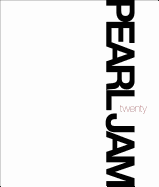
| Publisher: | Simon & Schuster | |
| Genre: | General, Biography & Autobiography, Rock, Music, Composers & Musicians, History & Criticism | |
| ISBN: | 9781439169216 | |
| Pub Date: | September 2011 | |
| Price: | $40 |
| Nonfiction |
by Pearl Jam, Cameron Crowe
In a scene from Cameron Crowe's 1992 film Singles, a musician named Cliff waxes philosophically on how modern music--and the fans' relationship to music--isn't what it used to be: "Where is the 'Misty Mountain Hop' of our generation?" Pearl Jam frontman Eddie Vedder, playing a fellow band member, shushes Cliff; he's interrupting the band's viewing of a documentary on bees. That's Pearl Jam in a nutshell.
Pearl Jam Twenty documents the band's first two decades together: studio dynamics, concert stories, song explanations and more. Crowe provides an introduction and intermittent insight from an outsider's perspective, but the bulk of the book is completely by the band (much like their music), with scores of previously unpublished backstage, tour and studio photos, a trove of anecdotes and memories, and insights into the making of each album. (As for Cliff's question? "Yellow Ledbetter," of course.) --Matthew Tiffany, counselor, writer for Condalmo
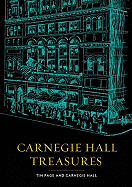
| Publisher: | Harper Design | |
| Genre: | Art, General, Music, Popular Culture, History & Criticism | |
| ISBN: | 9780061703676 | |
| Pub Date: | May 2011 | |
| Price: | $75 |
| Nonfiction |
by Tim Page, Carnegie Hall
Carnegie Hall Treasures offers an insider's history of the famous performance venue, but this isn't simply a collection of backstage tales. Instead, it's largely a tour of Carnegie Hall's extensive archives, with chapters tracing the composers, conductors, vocalists and musical genres that have been featured there through the years. Each slice of the hall's personality is captured through images and text in equal measure; photos and programs are contextualized with brief explanations. The jazz chapter is particularly delightful, studded with bold, colorful advertisements for concerts featuring greats like Miles Davis, Louis Armstrong and Sun Ra.
Perhaps the best part of the package, though, is the folder of memorabilia accompanying the handsome, sturdy book--the "treasures" of the title--containing reproductions of artifacts as varied as a 1943 telegram from Serge Koussevitzky to Leonard Bernstein and a program from a 1912 event hosted by the Society of American Magicians. These scraps of paper are a vivid testimony to the hall's lively history. --Kelly Faircloth, freelance writer
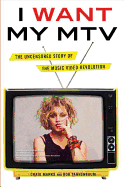
| Publisher: | Dutton | |
| Genre: | Performing Arts, General, Social Science, Television, Music, Popular Culture, History & Criticism, Genres & Styles | |
| ISBN: | 9780525952305 | |
| Pub Date: | October 2011 | |
| Price: | $29.95 |
| Nonfiction |
by Craig Marks, Rob Tannenbaum
Once upon a time, in the 1980s, the stranglehold of Music Television on youth culture was absolute; right-wing groups mobilized against its corrupting influence (in vain), and pop stars' careers were made and broken on the strength of their music videos. MTV's standing as the overlord of pop culture knowledge may have been eclipsed by the Internet (and by the network's gradual shift away from actually airing any music videos), but as Craig Marks and Rob Tannenbaum remind us in I Want My MTV, the channel spent more than a decade as top tastemaker. This is not a book for sociologists looking to deconstruct the objectification of women in Van Halen videos, but a buffet table of oral history, with an enormous cast of characters squeezing what feels like every possible anecdote out of the cable network's first decade. If the golden age of MTV warrants a memorial, this is the guestbook at the funeral and the headstone on the grave. Randee of the Redwoods himself couldn't ask for more. --Matthew Tiffany, counselor, writer for Condalmo
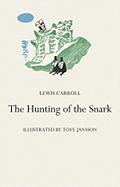
| Publisher: | Tate Publishing | |
| Genre: | Fiction, Classics | |
| ISBN: | 9781854379566 | |
| Pub Date: | September 2011 | |
| Price: | $12.95 |
| Poetry |
by Lewis Carroll, illust. by Tove Jansson
Far from fitful and agonizing, Lewis Carroll's The Hunting of the Snark is an absurdly humorous classic. Ten alliterate hunters set about their task, armed to the hilt with the care, forks, hope, ill-advised investments, smiles, soap and thimbles that will surely win them their prize. However, when the Baker warns, "If your Snark be a Boojum... you will softly and suddenly vanish away," the group suddenly feels slightly less prepared. They wisely decide to split up, encountering various dreams and dangers, including a frumious Bandersnatch, along the way. Originally published with the 1959 Swedish-language edition, the late Tove Jansson's whimsical black-and-white illustrations are now paired with the original English text. Jansson's Goreyesque drawings perfectly complement the nonsensical daydream of Carroll's longest poem. From the landing to the vanishing, this edition of The Hunting of the Snark is sure to enchant imaginative readers of all ages. --Sarah Borders, librarian, Houston Public Library
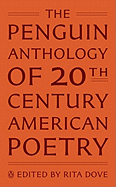
| Publisher: | Penguin Books | |
| Genre: | General, American, Anthologies (multiple authors), Poetry | |
| ISBN: | 9780143106432 | |
| Pub Date: | October 2011 | |
| Price: | $40 |
| Poetry |
by Rita Dove, editor
Curating a century's worth of poetry is a daunting task, to be sure, certain to meet objections from readers with their own ideas about what should be included. Instead of caviling, though, let's celebrate the gigantic four-year effort former U.S. poet laureate Rita Dove put into The Penguin Anthology of 20th Century American Poetry. Her primary criteria for inclusion were simple: Is this a voice that will be remembered? Did he or she make an impact that mattered? With those two guidelines, she proceeds through the century chronologically. She laments the inability to represent certain important poets--including Sylvia Plath and Allen Ginsberg--because of reprint fees, and cites the arbitrariness of confining herself to the 1900-1999 time frame, but even within these limitations, the book is a treasure. Dove's chronicle of "witness" poets, feminists, writing workshop poets, African-Americans, Beats, New York School poets, giants of the genre and small voices that have endured is a tour de force that will be with us for a very long time. --Valerie Ryan, Cannon Beach Book Company, Oregon